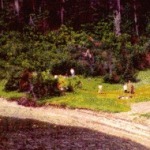Field School 1995: The Beaches (DeAk-1)
 Michael Deal (MUN) and Laurie McLean (Burnside Heritage Foundation) conducted limited archaeological and paleoethnobotanical testing at the Beaches site (DeAk-1) during the summer of 1995. The fieldwork was undertaken as part of an archaeological field school by the Archaeology Unit, Memorial University of Newfoundland, in conjunction with ongoing research by the Burnside Heritage Foundation. The field school involved four weeks (July-August) of on-site training in archaeological field techniques and site mapping. This fieldwork expanded upon previous work on the Beothuk component of the site, in terms of existing archaeological and ecological objectives.
Michael Deal (MUN) and Laurie McLean (Burnside Heritage Foundation) conducted limited archaeological and paleoethnobotanical testing at the Beaches site (DeAk-1) during the summer of 1995. The fieldwork was undertaken as part of an archaeological field school by the Archaeology Unit, Memorial University of Newfoundland, in conjunction with ongoing research by the Burnside Heritage Foundation. The field school involved four weeks (July-August) of on-site training in archaeological field techniques and site mapping. This fieldwork expanded upon previous work on the Beothuk component of the site, in terms of existing archaeological and ecological objectives.
The Beaches site is situated at the northern end of Bloody Reach, Bonavista Bay. This area is part of the North Shore Forest ecoregion, which has an irregular coastline, with numerous bays and inlets that extend far to the interior. It is also considered to be the driest part of the island, as well as the coastal ecoregion with the warmest summers. The area is composed of barrens, with black spruce and balsam fir as the dominant tree species. Relatively flat, wet peat bogs with various types of sphagnum moss are also well represented.
The Beaches is a multicomponent habitation site with extensive evidence of Maritime Archaic, Dorset Palaeoeskimo and Recent Indian occupations. Paul Carignan described the site location as "two low-lying, triangular points of land" that were originally part of a continuous gravel bar connecting the mainland and Fox Bar Island. The habitation site is located on the western side of the former gravel bar, below a steep talus slope. A former Beothuk burial site (DeAk-2) is located on Fox Bar Island.
The primary goal of the 1995 research was to conduct the first systematic paleoethnobotanical sampling of a Beothuk archaeological site. Paleoethnobotany is the recovery and interpretation of plant materials from archaeological contexts. Organic (archaeobotanical) remains can provide valuable information on the economic use of plants and site seasonality, as well as information on the natural environment at the time of occupation. At present we know very little about Beothuk plant use and our best potential source of new information is through paleoethnobotany. Since 1990, MUN paleoethnobotany classes have examined plant remains recovered from several prehistoric and historic sites on the island of Newfoundland, including Beothuk components at Boyd's Cove (DlAp-3), Notre Dame Bay, Deer Lake Beach (BhDi-6), Russell's Point (CiAj-1), Trinity Bay and Ferryland (CgAf-2). Only the Ferryland and Russell's Point samples were collected with paleoethnobotanical analysis in mind.
Another important goal of the 1995 research was to investigate the possible contemporaneity of the Beothuk housepits in Area A. The presence of iron artifacts alone is enough to place a structure within the historic period. Closer estimates of contemporaneity can be made using C14 dates on organic materials (especially charcoal), the comparison of material culture from all housepits and the refitting of artifacts and faunal specimens.
The 1995 fieldwork also permitted us to address other questions relating to the Beothuk occupation of the Beaches site. One important issue concerns the nature of the iron artifact assemblage from Area A. Housepits 4 and 6 produced iron artifacts typical of inland assemblages, while housepit 4 also had yielded artifacts characteristic of coastal collections. Previously unanalysed faunal remains from Housepit 5 were examined. This permitted a reassessment of our knowledge of faunal exploitation by Beothuk inhabitants of the Beaches. Further information was also collected concerning local lithic procurement strategies.
The proceeding summary is adapted from The Beaches Archaeological-Paleoethnobotanical Project: 1995 Fieldwork Report by Michael Deal and Laurie McLean. (1997) Newfoundland and Labrador Historic Resources Division, Department of Tourism and Culture, Government of Newfoundland and Labrador, St. John's.